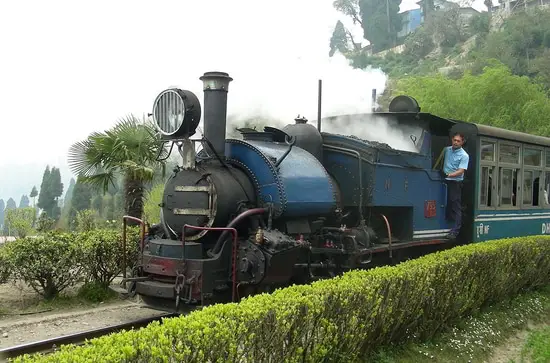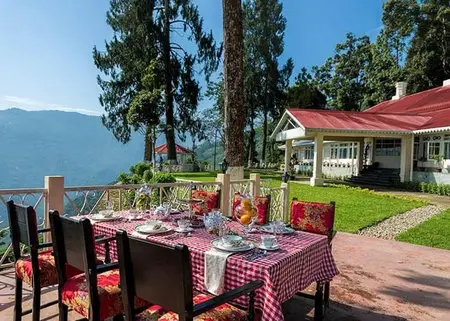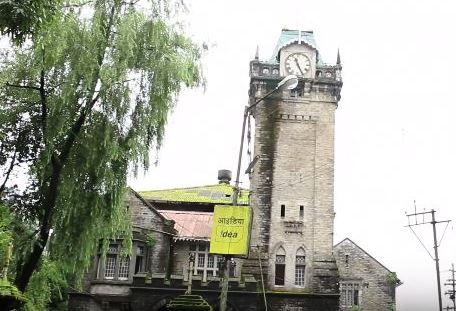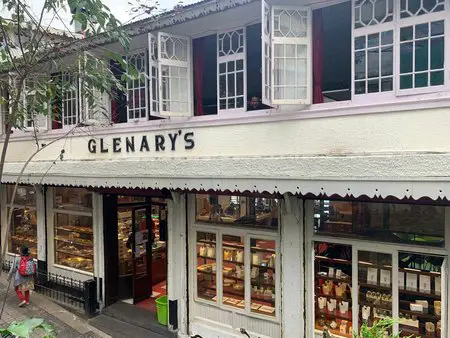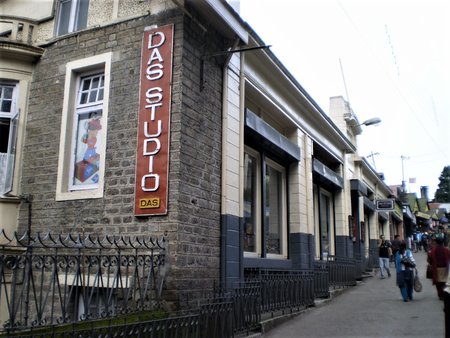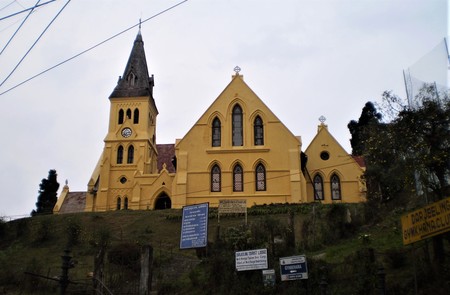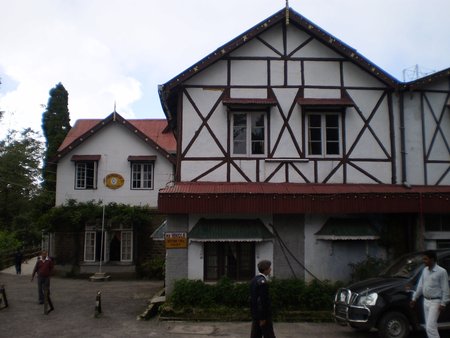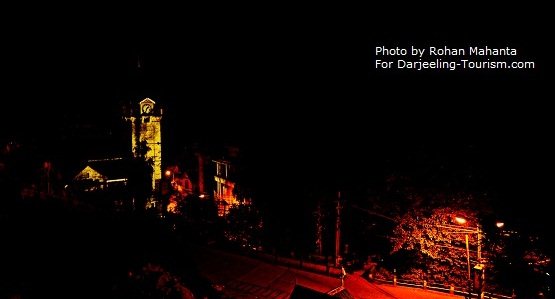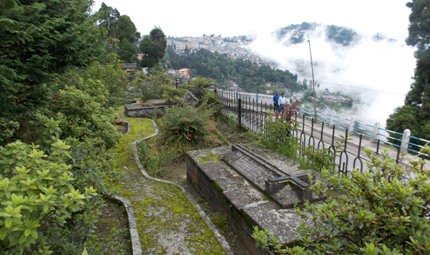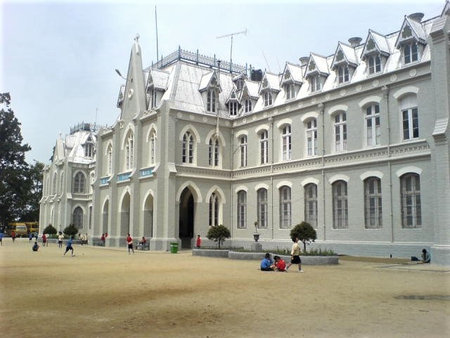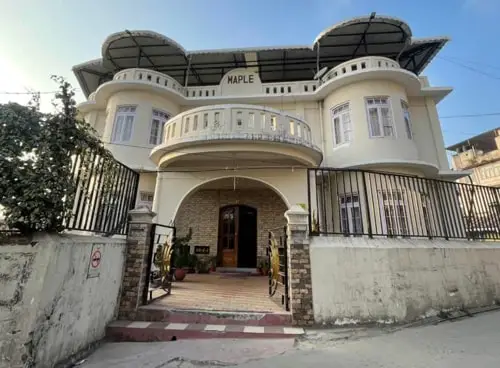Darjeeling Heritage Walk
I have designed a rare heritage walk for you in Darjeeling, a place which is steeped in British colonial history & heritage. The regular tour operators do not usually offer such guided walking tours.
From the 1800s, the British colonial administration had left behind many historical landmarks and heritage buildings including memorials & monuments, churches, parks, schools, clubs etc. There are centuries old historical buildings & houses in Darjeeling that reflect the traditional British architecture.
The
Toy Train of Darjeeling Himalayan Railway that runs on a narrow gauge track from the lower plains all the way up to Ghoom at 7407ft (the highest point on any railway track in India) and then up to Darjeeling, is considered to be an engineering marvel.
Steam Engine Toy Train at Batasia Loop, Darjeeling
Several amazing loops and zigzags were created on the tracks so that the train could negotiate the steep gradients. It is accorded the UNESCO World Heritage status.
Darjeeling has been the world's top tea producing place and known all over the world for the tea gardens producing "Champagne of Tea". Most of these sprawling tea estates were set up during the colonial days and still thriving. Many still have the original planters' bungalows (restored in several tea gardens) which continue to exude the old colonial aura.
Ging Tea Estate Bungalow, Darjeeling
You will be surprised to know that several of these old tea gardens have still retained tea bushes that are more than 150 years old and these were planted by the British planters.
Darjeeling had been the home of Tenzing Norgay who was the first to climb Mount Everest along with Edmund Hillary in 1953. The Himalayan Mountaineering Institute was built in Darjeeling to commemorate this unsurpassed achievement and train climbers from all over the world to attain such level of success. It has since become the Mecca of all mountaineering students aspiring to climb the Himalayan peaks.
And the people & culture, unique flora & fauna, majestic mountains & valleys and many other great old & modern attractions all add to the rich heritage of Darjeeling.
The self-guided walking tours below attempt to give you a glimpse of all this. However, you should be prepared to walk along the hilly roads that may sometimes be quite steep. You can do a half day or a full day heritage walk. Suggest that you wear good walking shoes and carry a bottle of drinking water.
Here are the landmarks and heritage points covered in the walking tours I have designed. You will get directions to take a self guided walking tour in the last section.
Half Day Heritage Walk
The walk starts from Gandhi road which is one of the main roads of Darjeeling town. This road was once known as Tanga Road. Tanga in local language means horse drawn carriage. There was a time when only horse carriages were used as transport on this road and hence such a name.
Planter's Club: It was established in 1868 for the British planters and their wives to enjoy the evenings. Many other business tycoons and known personalities visited the club and stayed in the colonial rooms. This club was the starting point of the ill fated expedition of Mt. Everest in 1924 that was led by Irvine and Mallory, who never returned.
Several well known landmarks along Laden-La road. One is Darjeeling Municipality Building where the famous Clock Tower forms the front part. The huge clock plays a lovely musical tone followed by dings of the bell at every hour. The building was constructed in 1850 and it was then the Town Hall of Darjeeling. Later it was converted into municipality building. It's located centrally in Darjeeling town on Ladenla Road and very close to the junction of Gandhi Road and Ladenla Road.
Darjeeling Clock Tower
Further ahead on Ladenla Road is Darjeeling Head Post Office which is a UNESCO World Heritage Site. The post office opened in May 1921 and is one of the oldest post offices in the region.
You will see two of the century old restaurants on Nehru Road both of which are historic and came up during the British time. Keventer's is all that remains of Edward Keventer's dairy farm in Ghoom. The farm was once famous for its dairy & piggery products. However Keventer's restaurant is still very dear to all for its hearty breakfast with bacon, sausages and meat loaf.
The other one is
Glenary's which was founded by an Austrian named Pliva. It has a famous Bakery & Tea Room at the ground floor and a multi-cuisine restaurant in the upper floor. It has recently expanded with a bar & disco "The Buzz" in the basement.
Glenary's
You will also pass by Das Studio, one of the oldest studios in Darjeeling that was set up in 1927 and reach the Mall area. Here you can see some very old shops including Habeeb Mullick & Sons which is famous for wonderful handmade curios and special jewelry.
Walk up to the Observatory Hill & Mahakal Temple. This area on the hill top provides a sweeping view of the snow covered mountain peaks and the valleys. This is where stands the oldest Hindu Temple of Lord Shiva which is said to have self manifested in 1700s. There used to be a monastery here as well which was destroyed and later shifted to the Bhutia Busti down below.
Then visit St. Andrew's Church along the Mall road, an old Anglican church that was originally built in 1843. The construction cost at that time was Rs. 9,000. Along the interior walls of the church there are inlaid marble tables that retain the memories of many great residents of Darjeeling including that of Lt. General A. Lloyd who was the discoverer of Darjeeling.
St. Andrew's Church
Another attraction in the vicinity is Darjeeling Gymkhana Club that was established in 1909. Even after over 100 years, the club is fully operational and has recently added facilities. It has an excellent library, several badminton courts, card room etc. Although the facilities are available to the members, the club also allows temporary memberships to visitors to avail the facilities. There are en-suite rooms for holiday makers to rent. A large building (of 3-star category) has been recently added in the backside increasing the capacity of rooms.
Further down Mall road is the Government House or the Raj Bhavan. In 1840, it was a personal property of a British and subsequently changed hands. Finally it was bought over by Maharaja (King) of Cooch Bihar and later taken over by the Government in 1877.
Initially it was the residence of Governor of Bengal and was named as 'Shrubbery' in 1880. Over time several changes took place, for example the Governor Sir Ashley Eden added the tower and the front porch. Sir C. Elliott built the Durbar Hall. Raj Bhavan or the Government House is now the summer residence of the Governor of West Bengal.
Visit Bengal Natural History Museum which located within a walking distance. This museum preserves specimen of flora & fauna of the region. The building has three floors including a basement and is a ferroconcrete structure. It was built in 1915 after receiving funds from Lord Carmichael. The architect of West Bengal Government Mr. Crouch was the designer.
Update: In 2018, the museum has been relocated to HMI (Himalayan Mountaineering Institute) complex which is farther away (requires about 30 minute walk from the Mall). However you can still visit the old building and look at its primitive architecture.
The half day heritage walk ends here.
Darjeeling at night with Clock Tower in view
Full Day Heritage Walk
The full day walking tour covers all the points that are part of the above half day walk plus the following additional places:
Walk downhill towards the lower bazaar (chowk Bazaar) area, you will walk past the Jama Masjid that was originally built in 1850 and then rebuilt in the year 1910. You will then visit the Old Supermarket (a new supermarket has been built close by).
You will then walk by the Judge Bazaar, and visit Darjeeling Railway Station (which is the last toy train station on Darjeeling Himalayan Railway track) and then St. Columba's Church which was established in 1894 and located just above Darjeeling station.
Hooker Road (located off Lebong Cart road) is named after Sir Joseph Dalton Hooker, an eminent British botanist, biographer and traveler. He came to Darjeeling in April 1848 in an expedition which he continued through Sikkim and later returned to Darjeeling and wrote some of his precious journals. He left Darjeeling in May 1850. He was one of the closest friends of the famous naturalist Charles Darwin.
Joseph D Hooker stayed in Darjeeling with his friend and naturalist Brian Houghton Hodgson as his guest. The house where he stayed was known as Bryan Stone built in 1848 ... it's located in Jalapahar area and is presently the official Residence of the Rector of St. Paul's School, Darjeeling. Hooker wrote the world famous book - Flora of British India.
Himalayan Mountaineering Institute and the Zoo: Both HMI and the Darjeeling Zoo are located in the same complex. HMI was established in the honor of Tenzing Norgay after his successful climb of Mount Everest. It is now a pioneering institute giving lessons on mountaineering and rock climbing to students who come from all over the world. The Zoo is famous for its collections of rare high altitude animals of the Himalayas.
Old Cemetery: This is the resting place of many old British settlers including the one who is known to be the discoverer of Darjeeling.
Roy Villa (Sister Nivedita's House): This house on Lebong Cart Road is famous for two reasons. This is where Sister Nivedita (Disciple of Swami Vivekananda) lived last days of her life & breathed her last on 13th October 1905, and this is the same building where Himalayan Mountaineering Institute first started its operation in 1954 before moving to its current location in 1955.
St. Joseph's School (North Point) located on Lebong Cart Road. The school was initially setup in 1877 in a nearby bungalow for Catholic students. In 1879, when Fr. Joseph Peacock was the Rector of the school, a new building was setup which was named St. Joseph's Seminary. In 1891, it became a large structure. It is still one of the most prominent schools in Darjeeling.
Bishop's House: This beautiful building located in Lebong was built by Archbishop Dr. Carew in 1891 as a presbytery which housed the priests. Later it was named as Archbishop's House to distinguish the building from other Protestant churches. In 1962 after Darjeeling became Diocese, it was handed over to the first Bishop of Darjeeling and since then it is known as Bishop's House.
How to do the heritage walk?
Here is a brief guideline on how you can do the walk yourself without a guide:
Half Day Walk
Get to the traffic police point next to Clubside taxi stand. This is the junction of Gandhi Road, Nehru Road and Ladenla road.
On your right is Planter's club, on your left on Ladenla road you can see the Clock Tower. You can first visit the Clock Tower (the municipality building) followed by the Head Post Office, get back and visit the Planter's Club.
Walk up Nehru Road towards Chowrasta (Mall). You will come across Keventer's, Glenary's, Das Studio etc along the way (all of them will be to your left on the narrow uphill Nehru road).
At the Mall (Chowrasta) you will find the old curio store Habeeb Mullick & Sons.
From the Mall, take the Mall Road which is a circular road around Observatory Hill. Enter the Mall road from the right (east) side, then take the stairs / pathway to Mahakal temple.
Get back to Mall, now enter the Mall road on the left side. After 3-4 minute walk you will see Andrew's Church on the right opposite Gorkha Ranga Manch (also known as Bhanu Bhavan).
Further ahead on Mall road is Government House (Raj Bhavan).
Get back to Bhanu Bhavan area and ask somebody to show you the way to the erstwhile Bengal Natural History Museum which is on Robertson Road and at an easy walking distance (if you are interested to see the old building which once housed the museum. It has been now relocated to Darjeeling Zoo complex).
Full Day Walk
After the half-day walk, you can take your lunch if you want. For that either get back to the Mall area or Nehru road, and there are plenty of eateries including Glenary's where you can take your lunch. You can also take your lunch later at HMI premises in a restaurant.
Ask any local and walk down to Chowk Bazaar area. There are several routes. Here you will see Jama Masjid, Judge Bazaar etc.
From Chowk Bazaar walk along the main road (i.e. Lebong Cart road which becomes Hill Cart road) towards Darjeeling toy train station. Visit the station and St. Columba's Church.
From Darjeeling toy train station, walk back along the main road towards Chowk Bazaar again. Keep walking along the main road (i.e. Lebong Cart Road).
You will reach Hooker road (on the right after DM's Bungalow), HMI/Zoo (off Lebong Cart road uphill along a narrow lane), Old Cemetery (on the right and right after Krishna Residency service apartments), Roy Villa (you can see it perched high above on a cliff and on your right ), St. Joseph's School (a grand building on the left) etc.
By now you have walked a lot. You can take a passing shared jeep and get back to Chowk Bazaar area before heading back to your hotel.
Other historic buildings
There are several other historic buildings that are worth visiting which you may not be able to cover on a single day. You need at least a day more for a complete coverage.
Step Aside
This is the house where the famous Indian patriot Desbandhu Chittaranjan Das stayed in 1925 when leaders such as Mahatma Gandhi visited and met him to discuss future politcal plans of Congress party and India. It is now a museum which exhibits many personal belongings of Deshbandhu. The building is located very close to and at an easy walking distance from Chowrasta (town square).
Read:
Step Aside for further details and direction.
Bose Institute
The renowned scientist Acharya Jagadish Chandra Bose lived here between 1922 to 1933. The original building here was then known as Abbey House and Sanctum. The house in which he lived has been now converted into a museum showcasing many of his personal artifacts. This is now one of the centers of Bose Institute that carries out multi-disciplinary research work.
Several universities and research centers across the country use the facilities and research work of the center. Read
Bose Institute Darjeeling for further details.
Loreto Convent School, Darjeeling
The Loreto sisters came to Darjeeling in October 1846 and established the school which is now a top girls' school in Darjeeling. It initially opened to impart education to Catholic girls but extended its services to students of all religions. The school started with only two girl students. As the school grew over tome, the min building of the school was added in 1853. It has a large playground.
In 1903 a concert hall was added. Earlier it was mainly a boarding school. In 1907, there were 117 boarders out of a total of 211 students. However the hostel facility was discontinued in 1988. Presently the school has over 1600 students from different parts of India. Loreto Darjeeling is located on Convent Road at a walking distance from Chowrasta (Mall).
Thorn Cottage
This is where the famous Planter's Club was originally located. It was then known as Darjeeling Club. Thorn Cottage was built in 1868. Once Planter's Club moved to its new location, it became the PWD (Public Works Department) office of West Bengal Government. Presently it is used as staff quarters of government employees from various departments. It's located on HD Lama road.
Maple Tourist Lodge
Located on Eric Benjamin Road and behind Bhanu Bhawan, this impressive two-storied building with a large roof terrace and a circular balcony on the first floor, was constructed in 1934. It originally belonged to Shamsher Janga Bahadur, a Royal family member of Nepal. During the schooling days of His Majesty of Nepal Late Veer Vikram Shah who was admitted to St. Joseph's School in Darjeeling, this building became the residence of his parents. They all went back once his schooling was over.
However, before the family left, they handed over the property to the District Magistrate of Darjeeling, who in turn handed over the lodge to West Bengal Government. Today it is managed by GTA (Gorkha Territorial Administration). The property now operates as a tourist lodge. It's only 6-7 minute walk from the Mall.
Related Articles
|
Visitors' Reviews/Comments
Share your experience.
|
